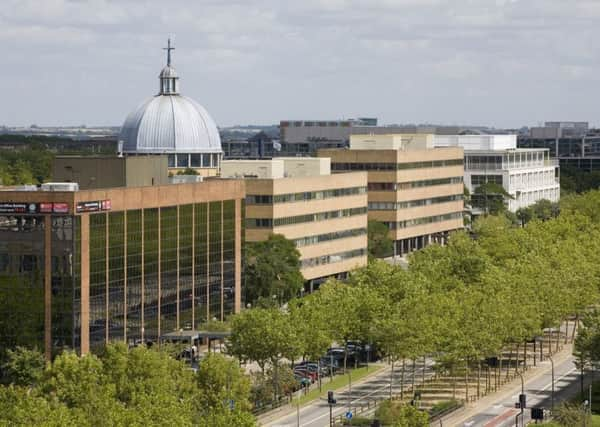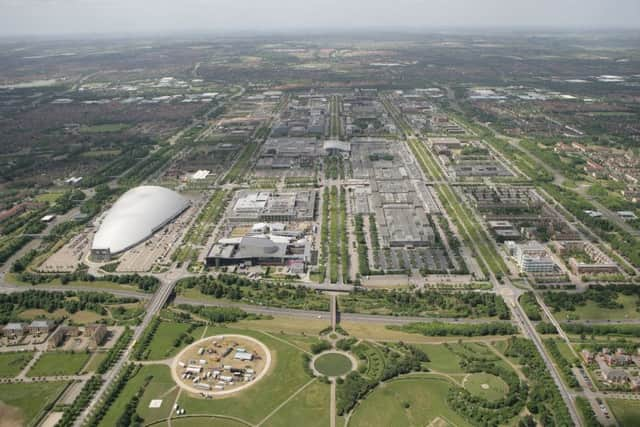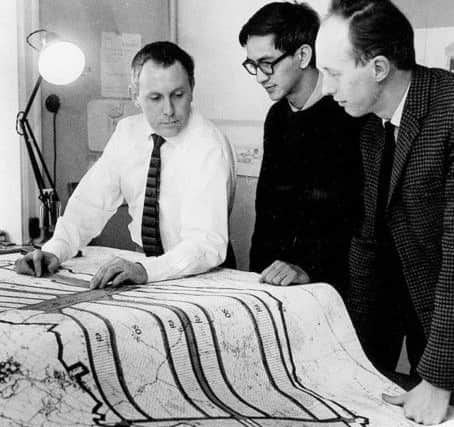It's been the butt of many jokes, but could Milton Keynes be the key to the housing crisis?


Bill Berrett has been looking at maps. Lots of maps. He’s been eyeing up potential sites for a groundbreaking development which, if he’s right, could provide the answer to the nationwide need for homes and jobs.
The ideal spot for what Berrett calls his northern business hub would be a brownfield site “somewhere south of Leeds and north east of Wakefield”. It might be called Priestley North, after Joseph Priestley the great Yorkshire scientist and innovator and it would be the result of his decades of experience as an architect and one of the pioneers behind the most iconic new town of them all - Milton Keynes.
Advertisement
Hide AdAdvertisement
Hide AdNow retired and living in Ilkley, Berrett’s blueprint addresses three matters very much in the news of late, namely the Northern Powerhouse, investment in infrastructure, and the national housing shortage. With constant pressure on greenbelt land, his is also an imaginative new approach to the use of brownfield sites.


This would not be a major new town or city such as Milton Keynes but a primarily business-focussed ‘hub’ – high-rise, low-carbon and very green – which would work in partnership with the big, established cities of West Yorkshire.
“My proposal seeks to show that, with vision, creativity and imagination, urban environments might offer sustainable, planet-friendly places to live, work and play,” says Berrett. “It’s not just about money, politics and power but about the environment enabling fulfilled lives to be led. Doing something of this kind makes the possibility of affordable housing much easier to achieve too.”
Berrett’s primary concern is with the quality of life for residents. “The most important thing is to create environmentally friendly, healthy places to live that are well governed and have access to an intense business hub for work,” he says. “The hardware is important in helping us get there but really it’s about the quality of life and people being able to participate in shaping that.” A key factor in all of this is the ability to think outside the box, take risks and commit to a vision, all of which the pioneers of Milton Keynes understood. “That project proved that these things are doable and that development can be fun,” says Berrett. “There are so many things that can be done if you are willing to invest in imagination and innovation.”
Advertisement
Hide AdAdvertisement
Hide AdBerrett is a man worth listening to. He joined Buckinghamshire County Council’s Department of Architecture and Town Planning in 1961. The graduate of Birmingham School of Architecture had already been part of the team that helped to rebuild post-war Coventry in the 1950s and now he was about to be at the forefront of realising an exciting vision of modern city living.


“I was in my early 30s and in 1962 my boss Fred Pooley, the county architect, asked me to think about what the implications would be of building a new city for a quarter of a million people,” recalls Berrett. “I had a room to sit in and think about it for about 10 days.
“I did think about it and I produced a report and drawings for him as well. I had to think about how much land you would need for a city of a quarter of a million people. Buckinghamshire had to the south of the county the wonderful Chiltern Hills greenbelt. It is near London so there was a huge development pressure and the council was constantly fighting battles about the incursion into the greenbelt but Fred Pooley’s general approach was that as an architect and planner he wanted to enable development.”
Berrett was told that what he was working on was confidential – the top secret project of ‘North Bucks New City’, later dubbed ‘Pooleyville’ – so much so that the report he produced had to be hand-written. “Having got some kind of idea on paper, we then built it into the county development plan,” says Berrett. “The idea was to preserve the greenbelt, have a degree of extension to towns like nearby Aylesbury and to develop the new city in the north of the county.
Advertisement
Hide AdAdvertisement
Hide Ad“It was such a wonderful site. It is almost exactly halfway between London and Birmingham and almost halfway between Oxford and Cambridge.”


Berrett, who has been based in Yorkshire for over 30 years, puts down much of the success of Milton Keynes in the planning stages to Pooley who he says was a man of vision. “This business about a vision is very important in this kind of work,” he says. “The amazing thing about Milton Keynes is that it literally started off from an idea that the people concerned, of which I was one, had – and that vision was carried out. Today we investigate everything and produce vast numbers of reports and then don’t do anything.”
Pooley also recognised that communicating with both the public and the local councils concerned was vital if the project was to go ahead.
“Before the official public announcement was made in 1964 we put in a lot of work talking to councillors and putting on slide shows, and later we did a series of public talks explaining what we were trying to do,” says Berrett. “We created a lot of plans for the surrounding towns in order to show the effect of building a city of a quarter of a million people in a rural area and the ways in which they could participate.”
Advertisement
Hide AdAdvertisement
Hide AdInitially, Pooley’s intention was that the whole city would be built around fare-free public transport, paid for through the rates, enabling people to move easily around the city.


“One of the difficulties we had at the time was that automated public transport systems were still in their infancy,” says Berrett. “We had to use the term ‘monorail’ which came across as a bit Dan Dare-ish.” In fact, by the time the plans were finally realised, there had been a slight change in attitude. “Towards the end of the 1960s thinking had shifted to some degree towards this love affair with the American Dream,” says Berrett. “And the consultants appointed by the Milton Keynes development corporation had a different kind of attitude towards the motor car.”
Had things turned out differently, Milton Keynes might well have become – way ahead of its time – the world’s first eco-friendly city.
Berrett subsequently joined Milton Keynes Development Corporation as director of planning in 1968 before a spell in New Zealand. Returning to the UK in 1980, he joined the department of civil engineering at the University of Leeds where he was a senior lecturer in architecture until his retirement in 1991.
Advertisement
Hide AdAdvertisement
Hide AdHe recently went back to visit Milton Keynes and it was, he says, a great experience. “It’s a wonderful thing to go there now and to see people living fulfilled lives in good quality housing in an environment which is pretty green,” he says. “Milton Keynes has been enormously profitable in terms of private enterprise, money and in terms of people being housed and jobs being created.”
For more information about Bill Berrett’s life and work visit billberrett.info